Abstract
Total and antimicrobial agent-resistant aerobic and facultative anaerobic gram-negative enteric bacilli in fecal samples of broiler chickens fed growth-promotional levels of antimicrobial agents were determined quantitatively. Two 8-week studies were conducted utilizing groups of chickens fed antimicrobial-supplemented rations; the second study involved feed "pasteurization" as a means of minimizing colonization from the feed. Dilution/spread-plating/replica-plating techniques on selective media were used to obtain counts of total organisms and those resistant to tetracycline, chloramphenicol, streptomycin, ampicillin, or kanamycin. The predominant aerobic and facultative anaerobic gram-negative organism was Escherichia coli, which was detected in all samples at levels ranging from 10(5) to over 10(10) CFU/g of feces. Less common were Proteus mirabilis, Klebsiella pneumoniae, and Pseudomonas sp., which varied in occurrence and levels from group to group (range, less than 10(3) to 10(8) CFU/g). Resistance to all antimicrobials (except chloramphenicol in E. coli) was commonly observed at incidences exceeding 10(3) CFU/g in the total populations. Colonization of the chickens' intestinal tracts by susceptible and resistant strains of E. coli, K. pneumoniae, and Pseudomonas sp. appeared to result from their presence in the environment of the newly hatched chickens. Ration pasteurization did affect P. mirabilis, which appeared to colonize from the feed. The results suggest that colonization by, and proliferation of, antimicrobial-resistant aerobic and facultative anaerobic gram-negative enteric bacilli in chicken intestinal tracts may be less dependent on selection through antimicrobial supplementation of the ration than on their prevalence in environments from which they can colonize newborns.
Full text
PDF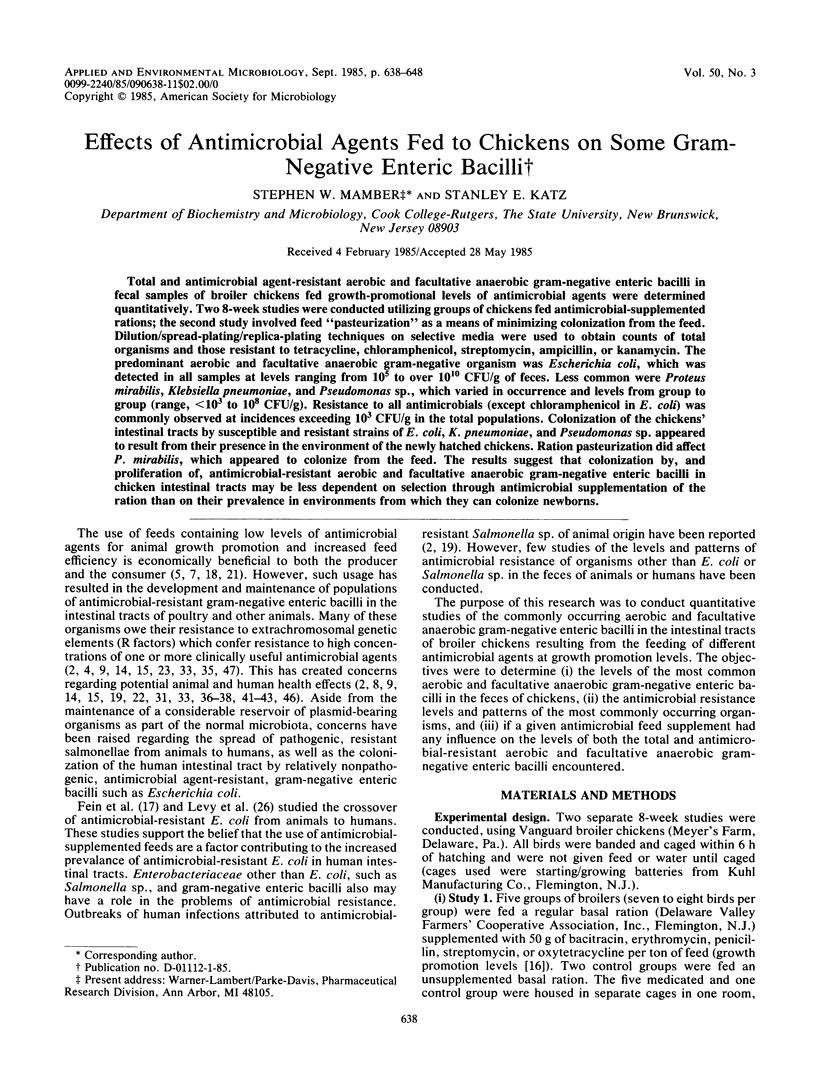
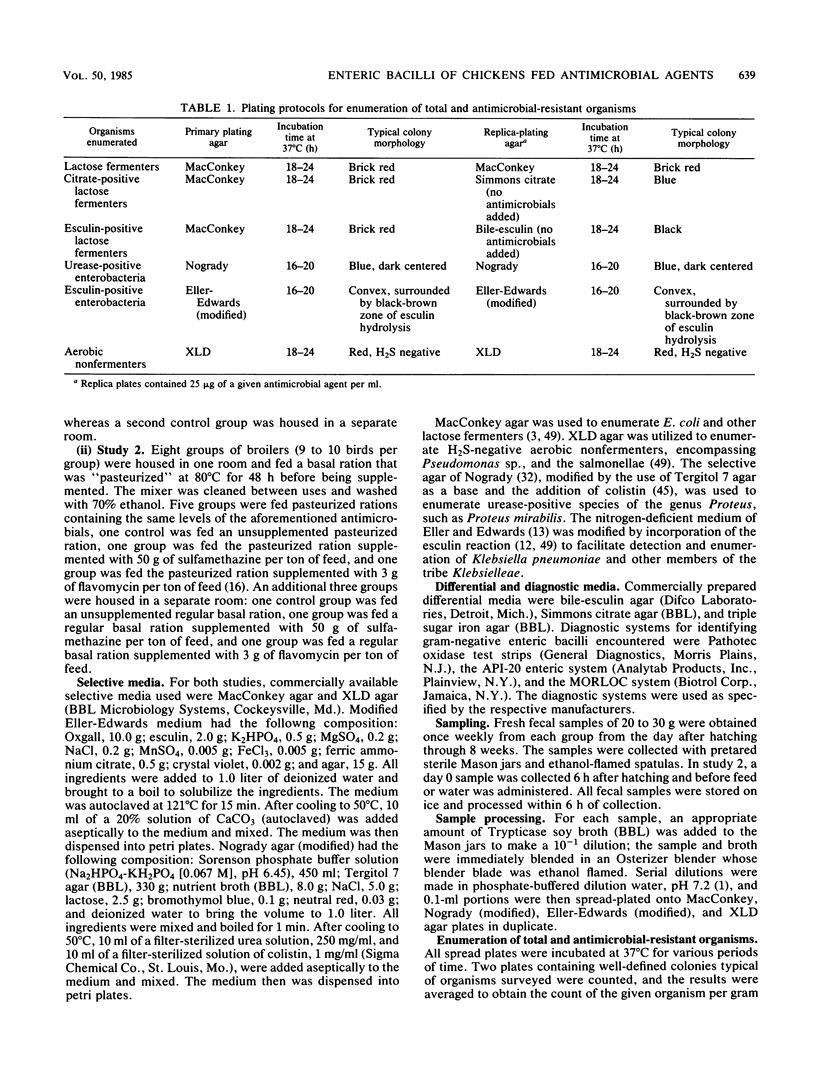
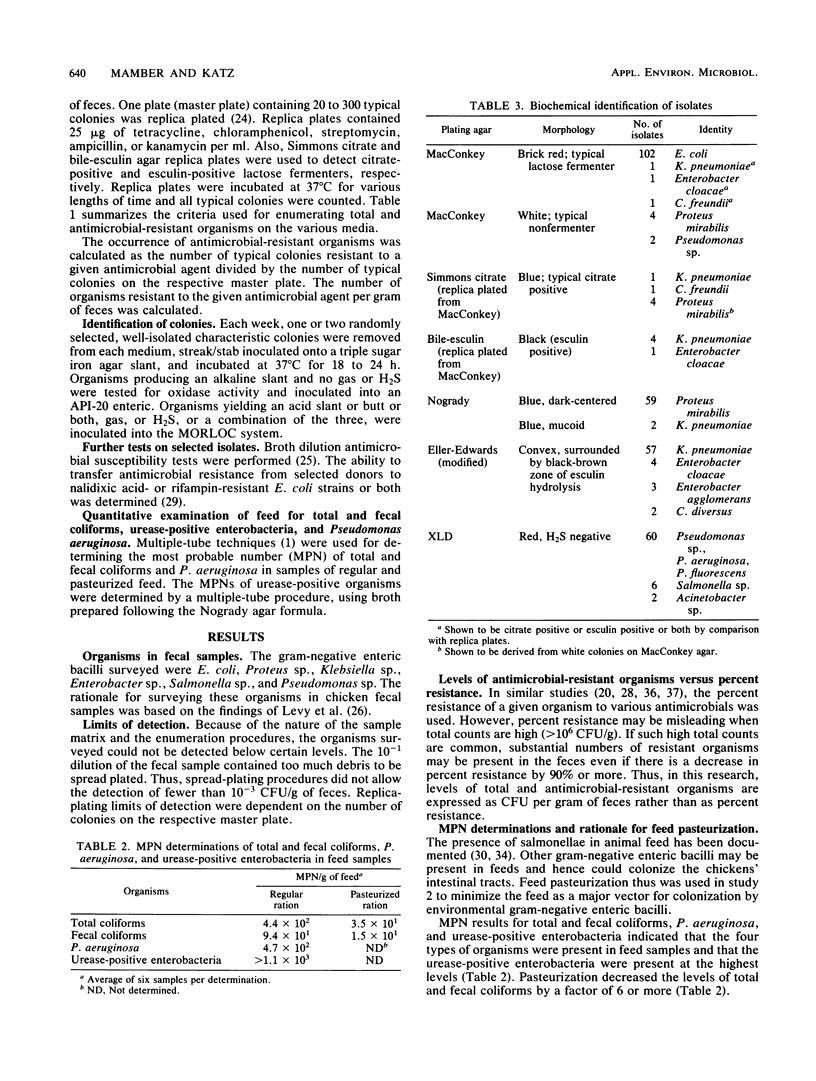
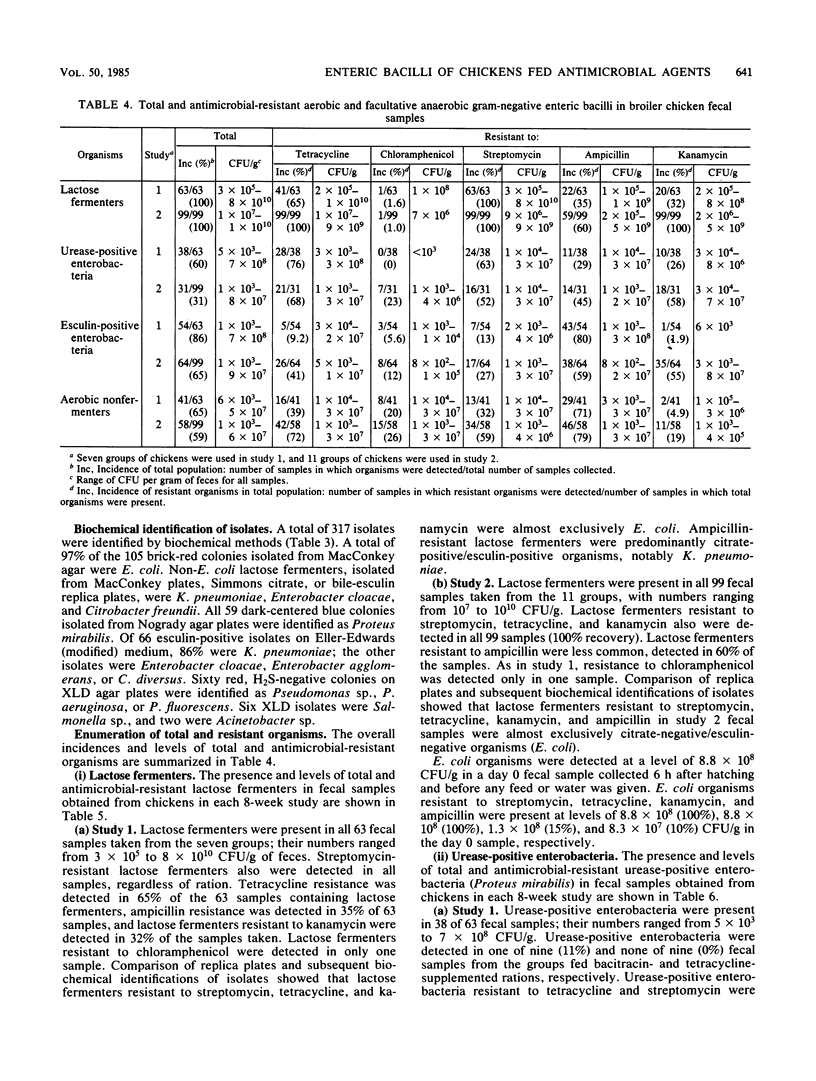
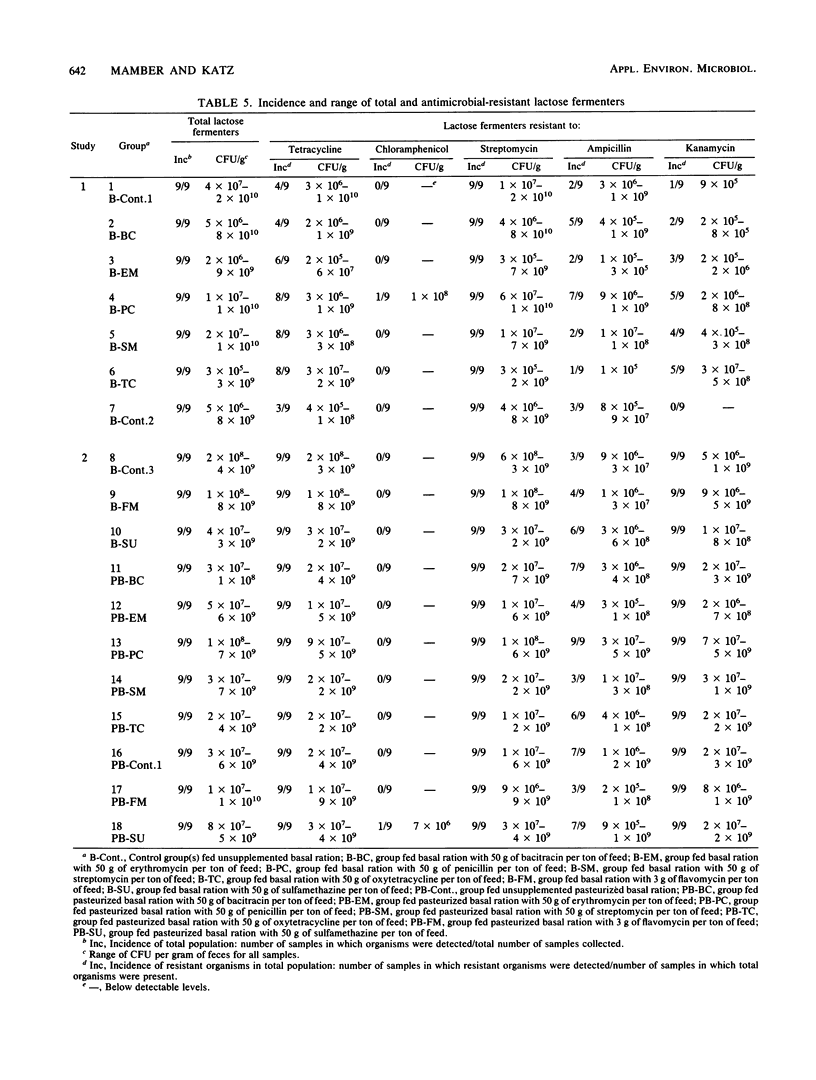
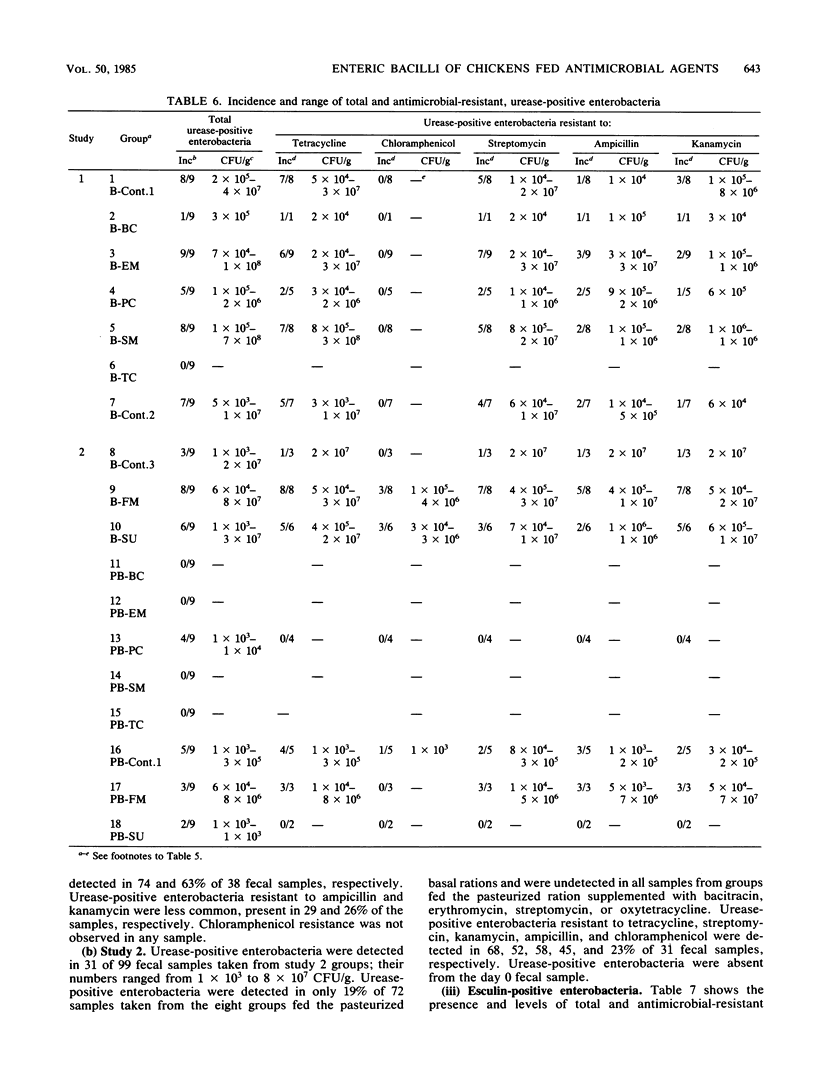
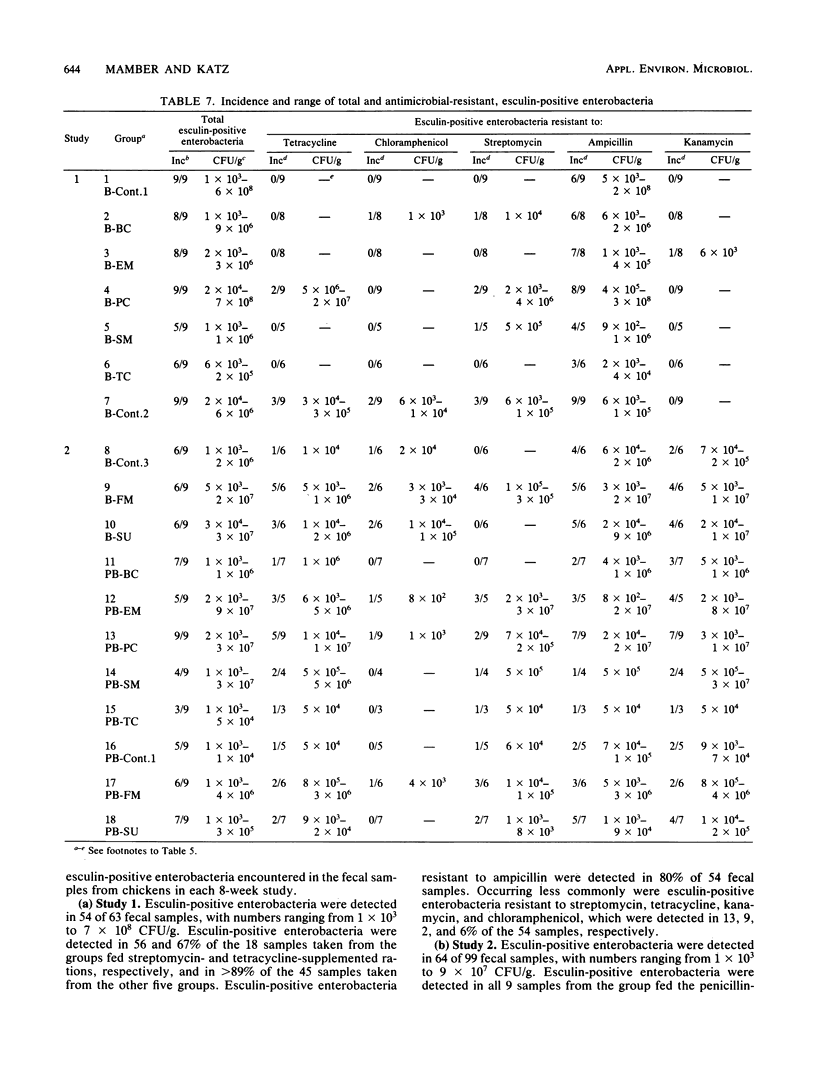
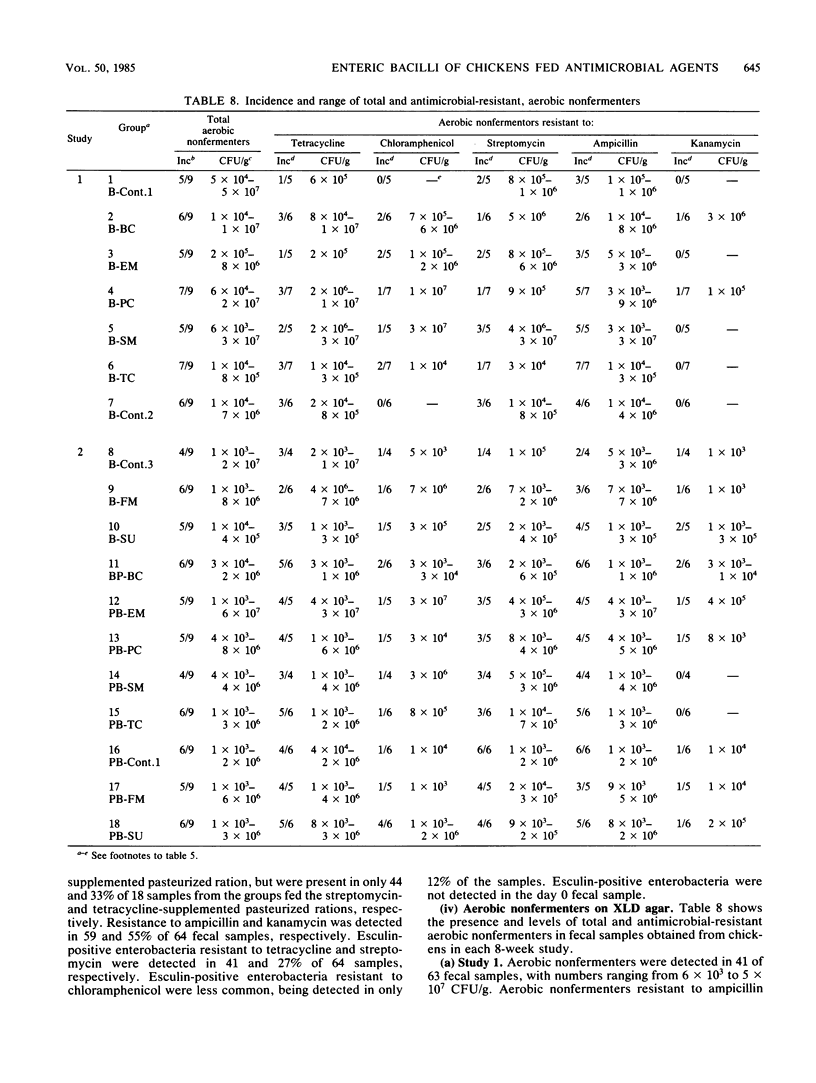
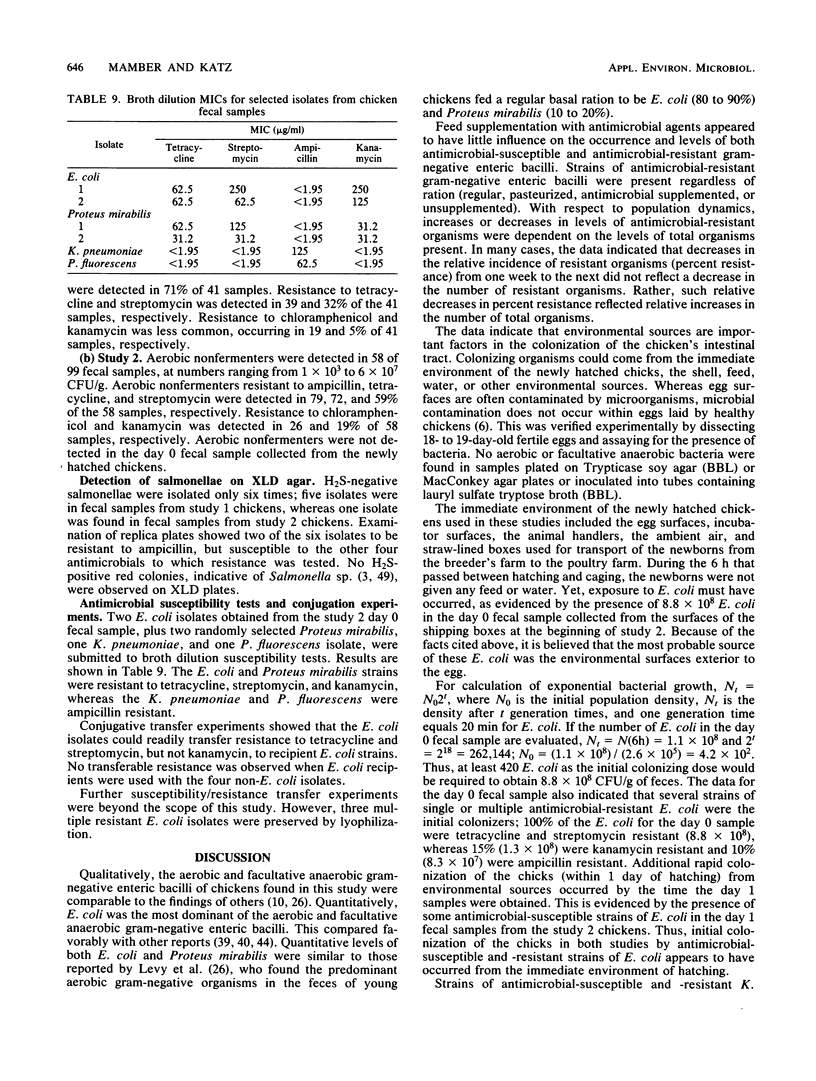
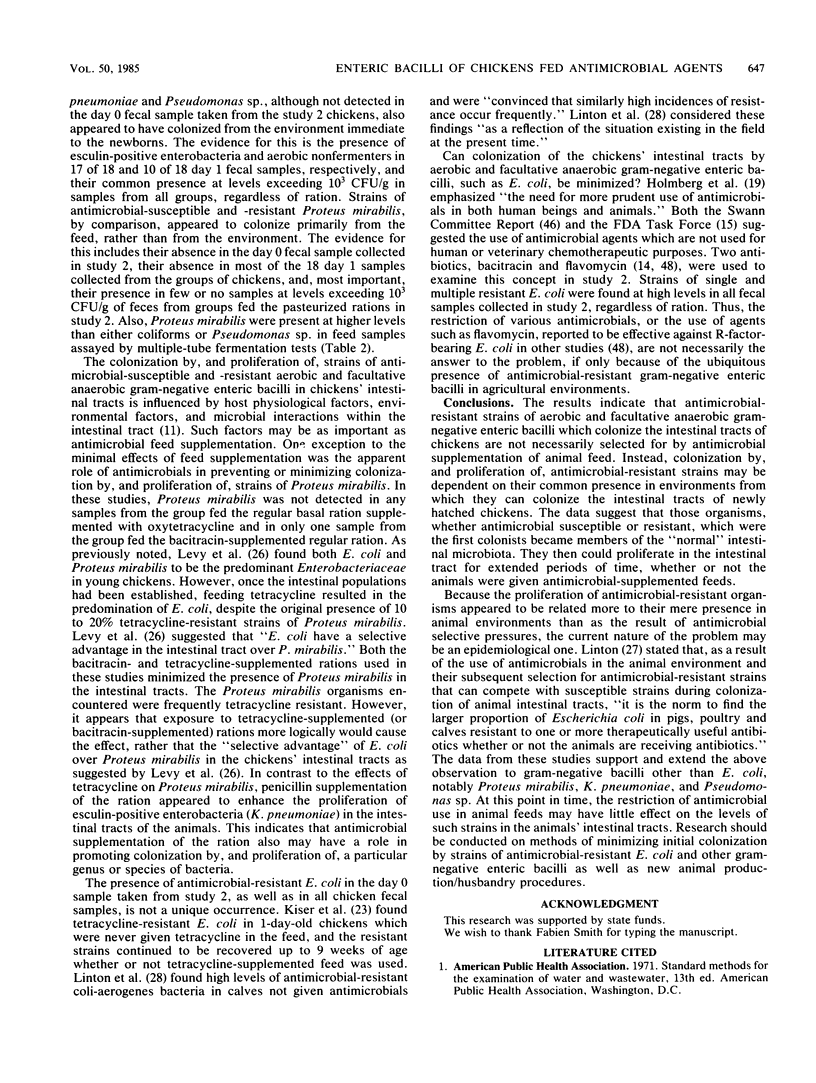
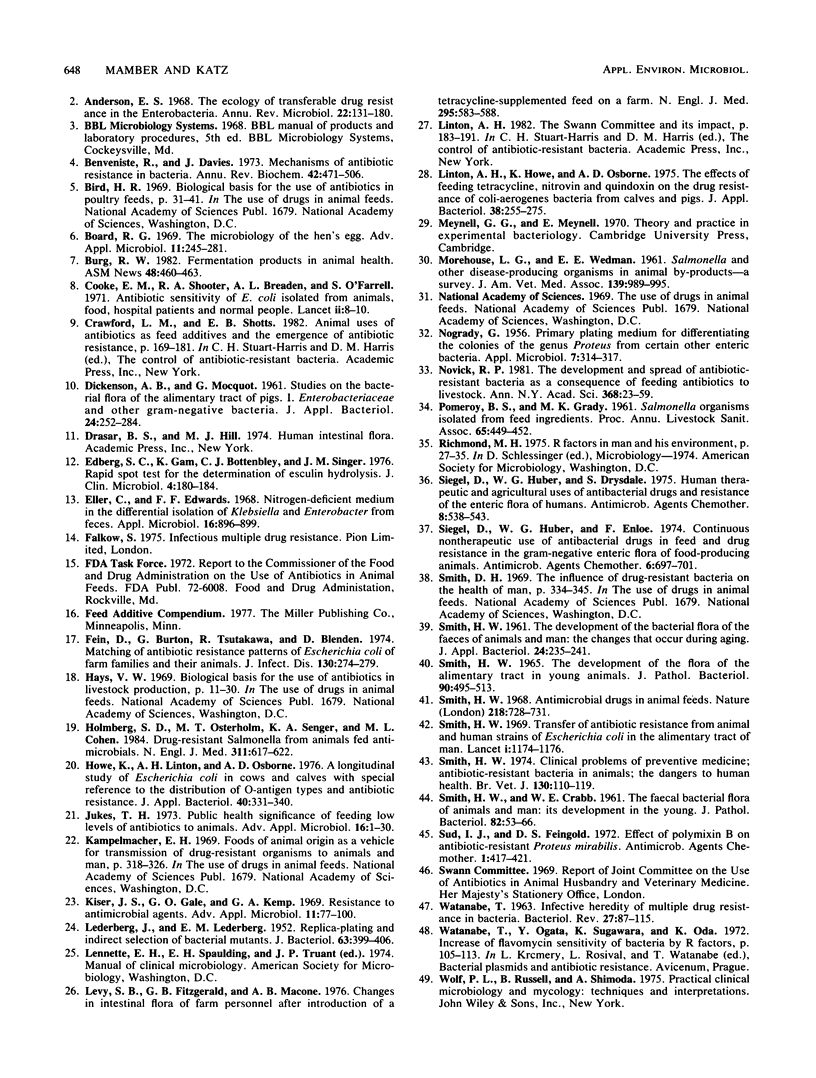
Selected References
These references are in PubMed. This may not be the complete list of references from this article.
- Anderson E. S. The ecology of transferable drug resistance in the enterobacteria. Annu Rev Microbiol. 1968;22:131–180. doi: 10.1146/annurev.mi.22.100168.001023. [DOI] [PubMed] [Google Scholar]
- Benveniste R., Davies J. Mechanisms of antibiotic resistance in bacteria. Annu Rev Biochem. 1973;42:471–506. doi: 10.1146/annurev.bi.42.070173.002351. [DOI] [PubMed] [Google Scholar]
- Board R. G. The microbiology of the hen's egg. Adv Appl Microbiol. 1969;11:245–281. doi: 10.1016/s0065-2164(08)70612-9. [DOI] [PubMed] [Google Scholar]
- Cooke E. M., Breaden A. L., Shooter R. A., O'Farrell S. M. Antibiotic sensitivity of Escherichia coli isolated from animals, food, hospital patients, and normal people. Lancet. 1971 Jul 3;2(7714):8–10. doi: 10.1016/s0140-6736(71)90004-3. [DOI] [PubMed] [Google Scholar]
- Edberg S. C., Gam K., Bottenbley C. J., Singer J. M. Rapid spot test for the determination of esculin hydrolysis. J Clin Microbiol. 1976 Aug;4(2):180–184. doi: 10.1128/jcm.4.2.180-184.1976. [DOI] [PMC free article] [PubMed] [Google Scholar]
- Eller C., Edwards F. F. Nitrogen-deficient medium in the differential isolation of Klebsiella and Enterobacter from feces. Appl Microbiol. 1968 Jun;16(6):896–899. doi: 10.1128/am.16.6.896-899.1968. [DOI] [PMC free article] [PubMed] [Google Scholar]
- Fein D., Burton G., Tsutakawa R., Blenden D. Matching of antibiotic resistance patterns of Escherichia coli of farm families and their animals. J Infect Dis. 1974 Sep;130(3):274–279. doi: 10.1093/infdis/130.3.274. [DOI] [PubMed] [Google Scholar]
- Holmberg S. D., Osterholm M. T., Senger K. A., Cohen M. L. Drug-resistant Salmonella from animals fed antimicrobials. N Engl J Med. 1984 Sep 6;311(10):617–622. doi: 10.1056/NEJM198409063111001. [DOI] [PubMed] [Google Scholar]
- Howe K., Linton A. H. A longitudinal study of Escherichia coli in cows and calves with special reference to the distribution of O-antigen types and antibiotic resistance. J Appl Bacteriol. 1976 Jun;40(3):331–340. doi: 10.1111/j.1365-2672.1976.tb04181.x. [DOI] [PubMed] [Google Scholar]
- Jukes T. H. Public health significance of feeding low levels of antibiotics to animals. Adv Appl Microbiol. 1973;16:1–54. doi: 10.1016/s0065-2164(08)70021-2. [DOI] [PubMed] [Google Scholar]
- Kiser J. S., Gale G. O., Kemp G. A. Resistance to antimicrobial agents. Adv Appl Microbiol. 1969;11:77–100. doi: 10.1016/s0065-2164(08)70607-5. [DOI] [PubMed] [Google Scholar]
- LEDERBERG J., LEDERBERG E. M. Replica plating and indirect selection of bacterial mutants. J Bacteriol. 1952 Mar;63(3):399–406. doi: 10.1128/jb.63.3.399-406.1952. [DOI] [PMC free article] [PubMed] [Google Scholar]
- Levy S. B., FitzGerald G. B., Macone A. B. Changes in intestinal flora of farm personnel after introduction of a tetracycline-supplemented feed on a farm. N Engl J Med. 1976 Sep 9;295(11):583–588. doi: 10.1056/NEJM197609092951103. [DOI] [PubMed] [Google Scholar]
- Linton A. H., Howe K., Osborne A. D. The effects of feeding tetracycline, nitrovin and quindoxin on the drug-resistance of coli-aerogenes bacteria from calves and pigs. J Appl Bacteriol. 1975 Jun;38(3):255–275. doi: 10.1111/j.1365-2672.1975.tb00530.x. [DOI] [PubMed] [Google Scholar]
- MOREHOUSE L. G., WEDMAN E. E. Salmonella and other disease-producing organisms in animal by-products-a survey. J Am Vet Med Assoc. 1961 Nov 1;139:989–995. [PubMed] [Google Scholar]
- NOGRADY G. Primary plating medium for differentiating the colonies of the genus Proteus from certain other enteric bacteria. Appl Microbiol. 1959 Sep;7:314–317. doi: 10.1128/am.7.5.314-317.1959. [DOI] [PMC free article] [PubMed] [Google Scholar]
- Novick R. P. The development and spread of antibiotic-resistant bacteria as a consequence of feeding antibiotics to livestock. Ann N Y Acad Sci. 1981;368:23–59. doi: 10.1111/j.1749-6632.1981.tb15430.x. [DOI] [PubMed] [Google Scholar]
- Siegel D., Huber W. G., Drysdale S. Human therapeutic and agricultural uses of antibacterial drugs and resistance of the enteric flora of humans. Antimicrob Agents Chemother. 1975 Nov;8(5):538–543. doi: 10.1128/aac.8.5.538. [DOI] [PMC free article] [PubMed] [Google Scholar]
- Siegel D., Huber W. G., Enloe F. Continuous non-therapeutic use of antibacterial drugs in feed and drug resistance of the gram-negative enteric florae of food-producing animals. Antimicrob Agents Chemother. 1974 Dec;6(6):697–701. doi: 10.1128/aac.6.6.697. [DOI] [PMC free article] [PubMed] [Google Scholar]
- Smith H. W. Anti-microbial drugs in animal feeds. Nature. 1968 May 25;218(5143):728–731. doi: 10.1038/218728a0. [DOI] [PubMed] [Google Scholar]
- Smith H. W. Clinical problems of preventive medicine. Antibiotic-resistant bacteria in animals: the dangers to human health. Br Vet J. 1974 Mar-Apr;130(0):110–119. doi: 10.1016/s0007-1935(17)35933-x. [DOI] [PubMed] [Google Scholar]
- Smith H. W. The development of the flora of the alimentary tract in young animals. J Pathol Bacteriol. 1965 Oct;90(2):495–513. [PubMed] [Google Scholar]
- Smith H. W. Transfer of antibiotic resistance from animal and human strains of Escherichia coli to resident E. coli in the alimentary tract of man. Lancet. 1969 Jun 14;1(7607):1174–1176. doi: 10.1016/s0140-6736(69)92164-3. [DOI] [PubMed] [Google Scholar]
- Sud I. J., Feingold D. S. Effect of polymyxin B on antibiotic-resistant Proteus mirabilis. Antimicrob Agents Chemother. 1972 May;1(5):417–421. doi: 10.1128/aac.1.5.417. [DOI] [PMC free article] [PubMed] [Google Scholar]
- WATANABE T. Infective heredity of multiple drug resistance in bacteria. Bacteriol Rev. 1963 Mar;27:87–115. doi: 10.1128/br.27.1.87-115.1963. [DOI] [PMC free article] [PubMed] [Google Scholar]


